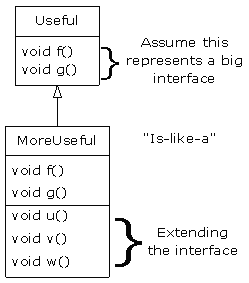Downcasting and run-time
type identification
Since you lose the specific type information via an upcast (moving up the inheritance hierarchy), it makes sense that to retrieve the type information—that is, to move back down the inheritance hierarchy—you use a downcast. However, you know an upcast is always safe; the base class cannot have a bigger interface than the derived class. Therefore, every message you send through the base class interface is guaranteed to be accepted. But with a downcast, you don’t really know that a shape (for example) is actually a circle. It could instead be a triangle or square or some other type.

To solve this problem, there must be some way to guarantee that a downcast is correct, so that you won’t accidentally cast to the wrong type and then send a message that the object can’t accept. This would be quite unsafe.
In some languages (like C++) you must perform a special operation in order to get a type-safe downcast, but in Java, every cast is checked! So even though it looks like you’re just performing an ordinary parenthesized cast, at run time this cast is checked to ensure that it is in fact the type you think it is. If it isn’t, you get a ClassCastException. This act of checking types at run time is called run-time type identification (RTTI). The following example demonstrates the behavior of RTTI:
//: c07:RTTI.java
// Downcasting & Run-Time Type Identification (RTTI).
// {ThrowsException}
class Useful {
public void f() {}
public void g() {}
}
class MoreUseful extends Useful {
public void f() {}
public void g() {}
public void u() {}
public void v() {}
public void w() {}
}
public class RTTI {
public static void main(String[] args) {
Useful[] x = {
new Useful(),
new MoreUseful()
};
x[0].f();
x[1].g();
// Compile time: method not found in Useful:
//! x[1].u();
((MoreUseful)x[1]).u(); // Downcast/RTTI
((MoreUseful)x[0]).u(); // Exception thrown
}
} ///:~
As in the diagram, MoreUseful extends the interface of Useful. But since it’s inherited, it can also be upcast to a Useful. You can see this happening in the initialization of the array x in main( ). Since both objects in the array are of class Useful, you can send the f( ) and g( ) methods to both, and if you try to call u( ) (which exists only in MoreUseful), you’ll get a compile-time error message.
If you want to access the extended interface of a MoreUseful object, you can try to downcast. If it’s the correct type, it will be successful. Otherwise, you’ll get a ClassCastException. You don’t need to write any special code for this exception, since it indicates a programmer error that could happen anywhere in a program.
There’s more to RTTI than a simple cast. For example, there’s a way to see what type you’re dealing with before you try to downcast it. All of Chapter 10 is devoted to the study of different aspects of Java run-time type identification.
